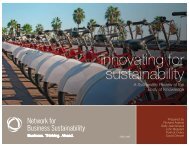Case Study - Network for Business Sustainability
Case Study - Network for Business Sustainability
Case Study - Network for Business Sustainability
You also want an ePaper? Increase the reach of your titles
YUMPU automatically turns print PDFs into web optimized ePapers that Google loves.
Engaging the Community: A Knowledge Project<br />
monitoring the effects of whale watching on whales. The challenge, however, will be to ensure that the<br />
persons assisting in this research receive sufficient training in scientific methods of capturing data such<br />
as population size, habitat, and behaviour. Sustainable management of the whale watching industry can<br />
best be achieved through continuing co-operation between research, conservation, and commercial<br />
interests. Research, education, and monitoring are essential parts of a sustainable whale watching<br />
industry and these activities will assist in determining whether the southern resident killer whale<br />
population is in fact declining and whether it is threatened by whale watching or other activities.<br />
The knowledge possessed by whale watch tour operators represents a significant resource. Most tour<br />
operators spend hundreds of hours on the water during the whale watching season and are often the<br />
first to become aware of the arrival of killer whales in the inland waters of BC and the San Juan Islands.<br />
They have in<strong>for</strong>mation about whale sightings, feeding locations, and patterns of habitat that may be<br />
very useful to researchers and conservation ef<strong>for</strong>ts.<br />
Government Regulation<br />
Government action has increased in response to a heightened public sense of the importance of proper<br />
whale watching management. The regulation of behaviours impacting killer whales in the San Juan<br />
Islands and Straight of Georgia is further complicated by the human boundary between Canadian and<br />
U.S. waters. In the U.S. marine mammals are managed by the National Marine Fisheries Service (NMFS)<br />
which has sole jurisdiction and supersedes any state or local government. In Canada, the Department of<br />
Fisheries and Oceans (DFO) is responsible <strong>for</strong> marine mammal conservation through the Marine<br />
Mammal Regulations (MMR) of 1993 passed under the Fisheries Act of 1993, and the Species At Risk Act<br />
(SARA) of 2004 (see Table 1 <strong>for</strong> details).<br />
Government involvement in regulating whale watching industry practices has been slow to develop. In<br />
Canada, the DFO has not been a significant en<strong>for</strong>cement presence in the BC region apart from a few<br />
high profile cases of prosecutions under the harassment regulations of the Marine Mammal Act, nor has<br />
it historically taken a major role in shaping whale watching industry practices in the BC region. In the<br />
State of Washington there is a minimum approach distance regulation of 100 yards. However, in British<br />
Columbia there are no specific marine wildlife viewing regulations.<br />
There has been some collaboration between US and Canadian authorities. For example, the U.S.<br />
National Marine Fisheries Service (NMFS) and the Washington Department of Fish and Wildlife teamed<br />
up with DFO (Pacific Region) to provide more water coverage during peak whale watching months in<br />
high traffic areas. The DFO has instructed fisheries en<strong>for</strong>cement officers to spend a portion of their<br />
water time observing whale watch activities in Canadian waters. While the en<strong>for</strong>cement is largely <strong>for</strong><br />
observing and providing additional support <strong>for</strong> the education and monitoring programs, it is also there<br />
to uphold existing U.S. MMPA, and Canadian MMR and SARA regulations.<br />
The whale watching industry is not comprehensively monitored through government regulation in either<br />
the U.S. or Canada. As a result the industry has turned to self-regulation, particularly through the<br />
WWOANW Best Practice Guidelines. As outlined below, non-governmental organizations such as<br />
6
















